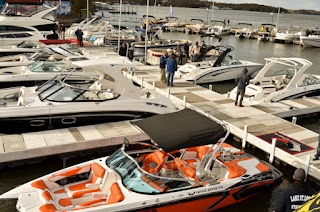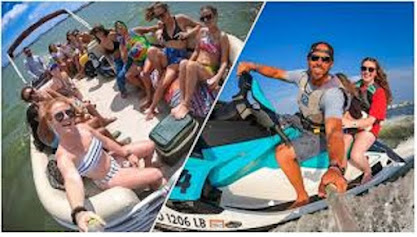What’s the Right Lifejacket For Me?
Water recreational activities are a big deal in Missouri.
Residents and visitors alike come to Missouri’s lakes and rivers to swim, boat,
ski, fish, and paddle. The emphasis, of
course, is on fun and enjoyment.
However, emphasis should also be placed on safety. No one
wants their vacation sadly interrupted by a drowning, especially if it involves
a child. Life jackets can (obviously)
help save lives.
So, what are lifejackets? Which one is right for you?
Missouri (and the Federal Government, through the Coast
Guard) have regulations regarding use of lifejackets, or more generally,
personal flotation devices, or PFDs. The
following is a summary of applicable PFD Regulations:
-
In Missouri, all vessels 16 feet or longer must
carry on-board at least one US Coast Guard (USCG)-approved wearable lifejacket
(PFD) for each person on board or being towed. Vessels less than 16 feet in
length must carry one wearable or throwable device for each person on board or being
towed. Note that Federal law requires a
wearable PFD for each person on board or being towed, regardless of vessel
length.
-
In addition to the above requirements, one
(USCG)-approved throwable device must be on board and readily accessible on all
vessels 16 feet or greater. A throwable
device is a throw cushion or life ring.
-
In Missouri, all children under the age of 7
(seven) must wear an appropriately-sized (USCG)-approved PFD (unless
below-decks in a cabin). Children’s life jackets are sized by weight; however,
they must also be placed on the child and appropriately buckled to verify fit.
Note: “Arm floaties” or “water wings” are NOT USGC approved for boating. However, the “Puddle Jumper” (combination
life jacket, swim aid and swim vest that a child slips his or her arms through
the arm floats of the puddle jumper, and then it buckles behind the back to
secure it) is USCG approved. They are
considered a Type III PFD (more on that in a moment). Note that the age
requirement varies from state-to-state; some states are more stringent, others
more lenient. However, if you are boating in Missouri, you must conform to
Missouri Boating Laws. Note also that Federal (USCG) regulations require PFDs
for children under the age of 13.
-
In addition to being (USCG)-approved, PFDs on
board a boat must be in serviceable condition, and readily accessible.
“Serviceable condition” means no tears, rips, holes or frayed fabric, and
operating clasps. “Readily accessible” per Missouri Boating Law means the PFDs
may NOT be stored in a “closed or locked” compartment. Also, PFDs may not be
stored in plastic or net bags. Federal regulations state that
“readily-accessible” means the ability to put on, adjust straps, and secure to
the person within 30 seconds.
What is “(USCG)-approved”? This
means that the US Coast Guard has tested the PFD and accepted it for use, based
on its Type Classification. All (USCG)-approved PFDs will have a stamp (usually
on the inside) stating that it is (USCG)-approved.
What does “Type Classification” mean”?
The Coast Guard classifies PFDs on their intended usage, and buoyancy
(flotation) rating. The following is a summary of the 5 Types of
(USCG)-approved PFDs:
-
Type I: Wearable Offshore Lifejacket. These are
designed for rough or remote waters where near-term rescue is not likely. They
provide the most buoyancy (flotation) and will turn most unconscious people
face-up. Most will also have a reflective stripe or panel attached.
-
Type II: Wearable Near-Shore Lifejacket. Similar to the Type I, they are intended for
calm waters, where rescue is more near-term. A Type II PFD may not turn an
unconscious person face-up.
-
Type III: Wearable Flotation Aids. Usually a
vest or full-sleeve jacket; designed for calm water where rescue is near-term.
Some “fishing vests” fall into this category.
-
Type IV: Throwable device. These throw cushions
and ring buoys are designed to be thrown to someone in trouble. It is not
intended for rough water, or for someone not able to hold on to it.
-
Type V: Wearable Special-Use Device. These are
vests, deck suits, hybrid PDFs and others that are designed for specific
activities such as wind-surfing, kayaking, or water skiing. Because they are
activity-specific, they are only acceptable for use for the specific
activit(ies) listed on the device. Some
inflatable fishing vests fall into this category. A Type V PFD is only
acceptable when being worn.
In Missouri, additional
requirements exist when operating Personal Water Craft (PWCs).
-
Everyone on board a PWC while underway must wear
a USCG-Approved Type I, II, II, or V PFD.
It is not required that lifejackets be worn when engaged in
swimming activities; however, it is a prudent idea to have children wear them
when in water over their head.
Remember, Lifejackets only save people when they are worn!




Comments
Post a Comment